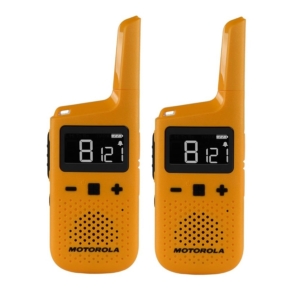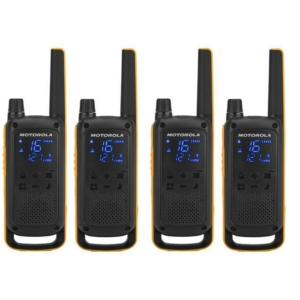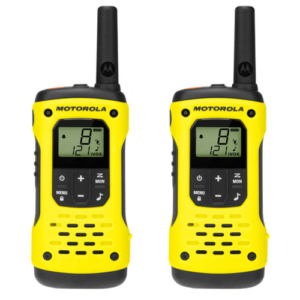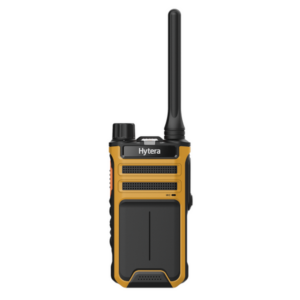Have you ever tried to make a call on your mobile phone with gloves on while waiting in line for the ski lift? Modern mobile phones are not designed for these conditions. Their batteries cannot handle the cold, you can't type on the touch screen with gloves, and they are also very fragile devices.
Radio communication can offer an excellent solution in the winter cold, allowing easy and efficient communication with others despite the cold weather.
Radio communication devices, such as walkie-talkies or handheld radios, come with many advantages in winter, snowy, and wet environments:
- Glove-friendly: Since radios have physical buttons, they can be easily operated even with thick gloves.
- Durability: Radios are generally more rugged and resistant to weather conditions than most smartphones.
- Robust casing: Radios are sturdier and less sensitive to cold and other weather conditions, reducing the risk of breakage even when dropped.
- Reliable communication: Radios are capable of working reliably in areas where smartphones have weak signal strength.

However, it is important to note that radio communication is different in nature and more limited in functionality compared to the versatile features offered by smartphones. But with a handheld radio, you can easily hold it in your hand and make a call. With just a press of a button, you can reach your companions on the same channel, making it a practical choice for group skiing or even ski instruction. It can be useful on the road for communication between cars, and it can also be handy in the evening for chatting between cabins.
Which device is ideal for winter sports?
Make sure to choose a waterproof radio, as it is important to withstand the wet environment in snowy conditions. It is also necessary to decide who will be using the device: children or adults?
You don't have to worry about running out of battery or forgetting to charge it, as some radios can also operate with AA batteries. Of course, nowadays almost all radios can be charged with a Micro USB or C-Type charger, which can be used with a power bank or portable solar panel.
One of the most popular choices: Motorola T82 Extreme walkie-talkie
The Motorola T82 Extreme has a sturdy exterior and is equipped with IP4 protection, making it resistant to moisture and slightly wet environments. It has many great features that can be useful during skiing. It can handle 16 channels and can initiate transmissions without pressing a button thanks to the VOX function. It has an emergency call function button that is compatible with the Motorola T92 H2O walkie-talkie. It can also be used with AA alkaline batteries if needed.

Less rugged but ideal for children: Motorola T72 walkie-talkie
The Motorola T72 has IP54 protection, which makes it more water-resistant than the T82 Extreme, although we still do not recommend it for swimming. The yellow housing can be easily seen in the snow. Its menu is simple and easy to use. Despite its small size and weight, it has a 1100mAh LI-ION battery. It can be charged with Micro USB, but the package also includes a docking charger and a carabiner. It has a VOX function for hands-free use, and it can also be used with earphone sets.

Waterproof Transceiver: 3rd Generation Motorola T92 H2O walkie-talkie
IP68-rated with a robust casing: the Motorola T92 H2O is 100% waterproof, allowing you to confidently use it even in snowy conditions! With 16 channels, 121 interference codes (subchannels), VOX, and dual watch features, this transceiver facilitates comfortable and practical communication. The vibrating call alert and built-in flashlight are extremely useful for winter hikes or sports activities. A unique feature is the instant alert button, which, when pressed in an emergency, emits a loud signal and switches to VOX mode. The built-in belt clip comes with an integrated whistle, further easing communication. Last but not least, it can be charged with a C-type charger.

Licence-free industrial devices: the Hytera AP515LF, AP525LF and BP515LF transceivers
We have three Hytera industrial PMR446 unlicensed transceivers in our portfolio that you can throw in with your ski equipment. The highlight of two of them is the huge battery with a 4000mAh capacity, nearly 5 times larger than a Motorola T82 Extreme Walkie Talkie. So you can use the devices for up to a week on a single charge with optimal usage. Digital noise cancellation and speech highlighting are standard features on Hytera's devices. The device uses built-in algorithms to analyse incoming audio, separate speech from background noise and then minimise the noise, so you can communicate clearly and intelligibly in noisy environments. Speech enhancement makes the speaker's voice more intelligible and audible to the other party, even in noisy environments or with a weaker connection.
The Hytera AP515LF and AP525LF transceivers are very similar, but the AP525LF has a higher degree of protection of IP66. It can withstand moisture well. It can survive being left in the snow or even falling into a stream while skiing. The yellow colour also makes it easier to spot in natural environments. The Hytera BP515LF can communicate in digital DMR mode in addition to the traditional analog mode. The Hytera AP515LF and BP515LF are IP54 rated. If they fall in the snow, they will not have any problems, and they can also withstand humidity.

Useful Tips for Winter Transceiver Use
Why use a headset?
If your transceiver lacks moisture-resistant IPX protection, be cautious when using it in cold, humid, or snowy environments. Issues can easily arise when using a walkie-talkie during winter sports or while wearing wet, snow-covered gloves. Moisture from your breath, for example, can immediately appear on the radio's casing, and tiny water droplets can easily enter the device.
To avoid this, consider the following when making a purchase:
- Using a Headset or a Microphone: Keep the transceiver in your bag or coat pocket while communicating with a headset or microphone. This way, the device is protected from the cold and moisture.
- Mounting the Microphone: If you want to keep the device handy, attach the microphone to a lanyard. This is not only convenient but also protects the device from falling.
- Using a carry case: Many walkie-talkie devices come with special carrying cases that provide extra protection against drops and light precipitation. Using such a case can be practical for further safeguarding the device.
In addition to basic earpieces, external PTT button solutions can be practical, mostly suitable for open helmets. However, if someone doesn't mind a throat microphone, it can also be used with a closed helmet. This way, you don't have to take the transceiver out from under your clothing.
Another important thing to note is that when using an earpiece, the waterproofing of your transceiver may decrease, so pay attention to this. Ideally, the earpiece should be secured with a lanyard or carabiner on your clothing.
Range in Mountainous Terrain
It's essential to emphasize that transceivers do not operate with unlimited range (except for internet-based transceivers, which require a GSM network). The range can particularly decrease in mountainous terrain. However, if there is optical line-of-sight, radio communication is ensured since there is nothing to block the radio waves.
The range provided by manufacturers on the device's datasheet or box refers to optimal conditions and generally shows the maximum distance between the two devices in ideal circumstances. This value applies to open free spaces where the two devices can optically see each other. For example, it could be 1 km or even 35 km.
Where the eye can reach, we can also "radio" there. This thought helps us easily estimate how far we can communicate with a transceiver from a given location, as observing the environment is sufficient for distance estimation.
Can I take the company transceiver on a foreign skiing trip?
If it is not a standard PMR446 transceiver (walkie-talkie), it is better not to ask your boss for it. Since the majority of industrial transceivers require a frequency license, their use is only allowed within national borders. These devices cannot be used in other countries.
However, if it's an professional PMR446 transceiver, such as the Motorola XT420 or the Hytera AP515LF, feel free to use them outside of Hungary. These devices operate on the standard PMR446 band, which can be used without a license throughout Europe.
Extra tip!
Whether using rechargeable or alkaline batteries, be extra vigilant about the device's charge due to the cold. Since battery capacity can significantly decrease in the cold, it's advisable to keep the transceiver and spare battery/walkie-talkie warm (e.g., store them in the inner pocket of your coat).
If you wear the transceiver outside your clothing, both you and the transceiver will get cold. When you arrive at your accommodation, don't immediately place the device in a warm location. Just as sudden hot water causes pain to your frozen hands, it can damage the transceiver. Wait until it slowly reaches room temperature before starting the charging process. If you need to dry a wet transceiver, avoid direct heat sources, such as a radiator or other hot surfaces! Place a piece of cloth under the device, free from the battery cover and battery, and put it on a warm surface, allowing it to dry for a few days.














